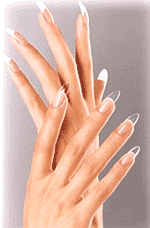 Fingernails and toenails grow from a point near the roots below the skin, at the base of the nail where the nail is very thin. White in color, and half-moon in shape, this semi-circle is appropriately named the "lunula, " and comprises a group of cells that manufacturekeratin, a dead, hoof-like protein. The keratin like protein produced, gathers and merges with the nail plate, the dead armor that protects the soft and tender nail bed underneath, and pushes the entire nail up and out. Though the fingernails and toenails grow an average of two inches per year, their growth slows with age, and the average adult's fingernails grow only one inch over the course of eight months. Fingernails and toenails grow from a point near the roots below the skin, at the base of the nail where the nail is very thin. White in color, and half-moon in shape, this semi-circle is appropriately named the "lunula, " and comprises a group of cells that manufacturekeratin, a dead, hoof-like protein. The keratin like protein produced, gathers and merges with the nail plate, the dead armor that protects the soft and tender nail bed underneath, and pushes the entire nail up and out. Though the fingernails and toenails grow an average of two inches per year, their growth slows with age, and the average adult's fingernails grow only one inch over the course of eight months.
The base of the fingernails and toenails, as well as some of the nail along both sides of the nail, are embedded into the skin. Unlike other skin, this skin contains elastic fibers that connect it to the fingernail or toenail, and hold it firmly in place. Thecuticle, a rim of skin over the lunula, protects it from bacterial infection, serves as a shock absorber, and shields the nail from any sudden impacts.
Though many consider dressing the fingernails up to go out a statement of beauty, or one of vanity, they serve those in the medical field as a diagnostic tool. Normally, the lunula, or half-moon, is white in color, indicating proper nutrition and good overall health. Blue lunula raise red flags that circulatory problems to the fingers may exist. Nails that are hard,brittle, and tend to split easily, may also be clues to poor circulation, infection, or disturbances of theglandularand nutritional systems.
Further nails that curl sharply around the finger point tocoronary, liver, or lung diseases. Nails that are sunken in appearance often indicateanemia, a condition where an insufficient amount of oxygen is carried by the blood.
|
指甲下端的白色弧影,甲弧影
角蛋白,角质
角质层
硬而脆的
腺的
冠状动脉
贫血症
|